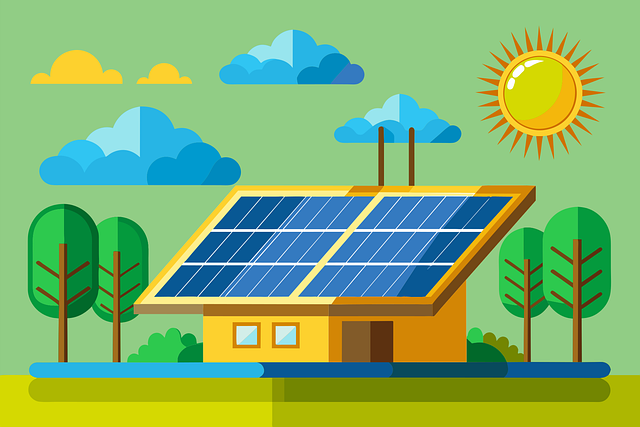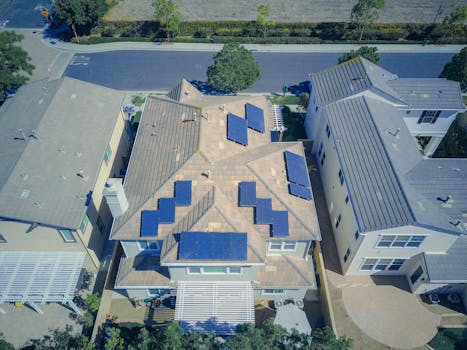“Empowering Smart Grids: Solar Mounting Systems for a Sustainable Future.”
Solar mounting systems play a crucial role in the integration of solar energy into smart grids, facilitating the efficient deployment and operation of photovoltaic (PV) systems. These structures not only support solar panels but also enhance their performance by optimizing their orientation and exposure to sunlight. In the context of smart grids, solar mounting systems contribute to the overall resilience and flexibility of energy distribution networks. They enable decentralized energy generation, allowing for better management of energy resources and improved grid stability. By facilitating the seamless connection of solar energy to the grid, these systems support the transition to renewable energy sources, promote energy independence, and contribute to the reduction of greenhouse gas emissions. As smart grids evolve, the design and implementation of advanced solar mounting solutions will be essential for maximizing the benefits of solar power in a sustainable energy future.
Integration of Solar Mounting Systems in Smart Grid Infrastructure
The integration of solar mounting systems into smart grid infrastructure represents a significant advancement in the way energy is generated, distributed, and consumed. As the world increasingly shifts towards renewable energy sources, solar power has emerged as a leading contender due to its accessibility and sustainability. However, the effectiveness of solar energy generation is heavily reliant on the efficiency of the systems that support it, particularly solar mounting systems. These structures not only secure solar panels but also play a crucial role in optimizing energy production and facilitating the seamless integration of solar energy into the broader smart grid framework.
To begin with, solar mounting systems are designed to maximize the exposure of solar panels to sunlight, which is essential for enhancing energy output. By utilizing adjustable and fixed mounting solutions, these systems can be tailored to specific geographical and environmental conditions, ensuring that solar panels operate at peak efficiency. This adaptability is particularly important in a smart grid context, where energy demand can fluctuate significantly throughout the day. By optimizing solar energy capture, mounting systems contribute to a more reliable and resilient energy supply, which is a fundamental goal of smart grid technology.
Moreover, the integration of solar mounting systems into smart grids facilitates real-time monitoring and management of energy resources. Smart grids utilize advanced communication technologies to gather data on energy production and consumption, allowing for dynamic adjustments to be made in response to changing conditions. Solar mounting systems equipped with sensors can provide valuable information regarding the performance of solar panels, including energy output and potential maintenance needs. This data can be transmitted to grid operators, enabling them to make informed decisions about energy distribution and storage, ultimately enhancing the overall efficiency of the grid.
In addition to improving energy management, solar mounting systems also support the decentralized nature of smart grids. Traditional energy systems often rely on centralized power generation, which can lead to inefficiencies and vulnerabilities. In contrast, smart grids promote a distributed energy model, where energy is generated closer to where it is consumed. Solar mounting systems facilitate this transition by enabling the installation of solar panels on residential and commercial rooftops, as well as in community solar projects. This decentralization not only reduces transmission losses but also empowers consumers to take an active role in energy production, fostering a sense of community and sustainability.
Furthermore, the integration of solar mounting systems into smart grid infrastructure can enhance grid stability and resilience. By diversifying energy sources and incorporating renewable technologies, smart grids can better withstand disruptions caused by extreme weather events or equipment failures. Solar mounting systems contribute to this resilience by allowing for the rapid deployment of solar panels in various locations, ensuring that energy generation can continue even when traditional power sources are compromised. This flexibility is essential in an era where climate change poses increasing risks to energy infrastructure.
In conclusion, the role of solar mounting systems in the integration of smart grid infrastructure cannot be overstated. By optimizing solar energy capture, facilitating real-time monitoring, supporting decentralized energy generation, and enhancing grid resilience, these systems are integral to the successful implementation of smart grids. As the demand for renewable energy continues to grow, the importance of effective solar mounting solutions will only increase, paving the way for a more sustainable and efficient energy future. The synergy between solar mounting systems and smart grid technology exemplifies the potential for innovation in the energy sector, ultimately contributing to a cleaner and more reliable energy landscape.
Enhancing Energy Efficiency with Solar Mounting Solutions

As the world increasingly shifts towards renewable energy sources, solar power has emerged as a leading contender in the quest for sustainable energy solutions. Central to the effective deployment of solar energy systems are solar mounting solutions, which play a crucial role in enhancing energy efficiency within smart grids. These mounting systems not only support solar panels but also contribute significantly to the overall performance and reliability of solar energy installations. By optimizing the positioning and orientation of solar panels, these systems maximize sunlight exposure, thereby increasing energy generation and efficiency.
One of the primary advantages of solar mounting systems is their ability to adapt to various environmental conditions and site-specific requirements. For instance, fixed-tilt mounts are designed to hold solar panels at a specific angle, which can be optimized based on geographic location to capture the most sunlight throughout the year. In contrast, tracking systems, which can move with the sun’s trajectory, further enhance energy capture by ensuring that panels are always positioned for optimal exposure. This adaptability is particularly important in smart grids, where energy demand can fluctuate significantly throughout the day. By maximizing solar energy production during peak sunlight hours, these mounting solutions help to stabilize the grid and reduce reliance on fossil fuels.
Moreover, the integration of solar mounting systems into smart grids facilitates better energy management and distribution. Smart grids utilize advanced technologies to monitor and manage energy flow, allowing for real-time adjustments based on consumption patterns. When solar energy is efficiently harnessed through well-designed mounting systems, it can be fed into the grid more effectively, reducing transmission losses and improving overall energy efficiency. This seamless integration not only enhances the reliability of energy supply but also supports the grid’s ability to accommodate a higher percentage of renewable energy sources.
In addition to improving energy capture and grid integration, solar mounting solutions also contribute to the longevity and durability of solar installations. High-quality mounting systems are engineered to withstand various weather conditions, including high winds, heavy snow loads, and extreme temperatures. By ensuring that solar panels are securely anchored and properly aligned, these systems help to minimize maintenance costs and extend the lifespan of solar installations. This durability is particularly important in the context of smart grids, where consistent energy production is essential for maintaining grid stability and meeting consumer demand.
Furthermore, as the technology behind solar mounting systems continues to evolve, innovations such as lightweight materials and modular designs are emerging. These advancements not only simplify installation processes but also reduce the overall environmental impact of solar projects. By streamlining the deployment of solar energy systems, these innovations contribute to the rapid expansion of renewable energy infrastructure, which is vital for achieving global sustainability goals.
In conclusion, solar mounting systems are integral to enhancing energy efficiency within smart grids. By optimizing solar panel positioning, facilitating better energy management, and ensuring the durability of installations, these solutions play a pivotal role in the transition towards a more sustainable energy future. As the demand for renewable energy continues to grow, the importance of effective solar mounting solutions will only increase, underscoring their critical role in the development of smart grids that can support a cleaner, more efficient energy landscape.
The Impact of Solar Mounting Systems on Grid Stability
The integration of solar energy into the power grid has become increasingly vital as the world shifts towards sustainable energy solutions. Central to this integration are solar mounting systems, which play a crucial role in ensuring the stability and efficiency of smart grids. These systems not only support solar panels but also contribute significantly to the overall performance of the grid, enhancing its reliability and resilience. As renewable energy sources like solar power become more prevalent, understanding the impact of solar mounting systems on grid stability is essential.
To begin with, solar mounting systems provide the necessary infrastructure for solar panels, ensuring they are securely positioned to capture sunlight effectively. This secure positioning is critical, as it directly influences the energy output of solar installations. When solar panels are optimally mounted, they can generate more electricity, which in turn contributes to a more stable energy supply. A stable energy supply is essential for smart grids, which rely on a balanced flow of electricity to meet demand. Therefore, the efficiency of solar mounting systems directly correlates with the overall stability of the grid.
Moreover, the design and technology of solar mounting systems have evolved to accommodate the dynamic nature of smart grids. Advanced mounting solutions, such as tracking systems, allow solar panels to follow the sun’s path throughout the day. This capability maximizes energy capture and enhances the predictability of solar power generation. As a result, grid operators can better manage energy distribution, reducing the risk of overloads or shortages. By improving the predictability of solar energy output, these mounting systems contribute to a more stable and reliable grid.
In addition to enhancing energy capture, solar mounting systems also play a role in mitigating the effects of environmental factors on grid stability. For instance, robust mounting solutions are designed to withstand extreme weather conditions, such as high winds or heavy snowfall. By ensuring that solar panels remain securely in place during adverse weather, these systems help maintain consistent energy production. This reliability is particularly important for smart grids, which must adapt to fluctuations in energy supply and demand. Consequently, the resilience of solar mounting systems directly impacts the overall stability of the grid.
Furthermore, the integration of solar mounting systems into smart grids facilitates the implementation of energy storage solutions. As solar energy generation can be intermittent, especially during cloudy days or at night, energy storage systems are essential for balancing supply and demand. Solar mounting systems can be designed to incorporate energy storage technologies, allowing for a seamless transition between energy generation and consumption. This integration not only enhances grid stability but also promotes the efficient use of renewable energy resources.
As the demand for renewable energy continues to grow, the importance of solar mounting systems in maintaining grid stability cannot be overstated. These systems are not merely passive supports for solar panels; they are active components that enhance the efficiency, resilience, and reliability of smart grids. By optimizing energy capture, withstanding environmental challenges, and facilitating energy storage, solar mounting systems play a pivotal role in the transition to a more sustainable energy future. In conclusion, as we move towards a more interconnected and intelligent energy landscape, the impact of solar mounting systems on grid stability will be a key factor in achieving a reliable and resilient power supply.
Future Trends in Solar Mounting Systems for Smart Grids
As the world increasingly shifts towards renewable energy sources, the integration of solar power into smart grids is becoming more prevalent. Central to this integration are solar mounting systems, which play a crucial role in optimizing the efficiency and functionality of solar energy installations. Looking ahead, several future trends in solar mounting systems are poised to enhance their contribution to smart grids, ultimately facilitating a more sustainable energy landscape.
One of the most significant trends is the development of advanced materials and technologies that improve the durability and efficiency of solar mounting systems. Innovations such as lightweight, corrosion-resistant materials are being adopted to reduce the overall weight of solar panels and their mounts, which can lead to easier installation and lower structural requirements. This not only streamlines the installation process but also allows for greater flexibility in site selection, enabling solar installations in previously unsuitable locations. As these materials continue to evolve, they will likely enhance the longevity and performance of solar arrays, making them more reliable components of smart grids.
Moreover, the rise of smart mounting systems equipped with tracking technology is another trend that is gaining momentum. These systems can adjust the angle of solar panels throughout the day to maximize sunlight exposure, thereby increasing energy production. By integrating tracking systems with smart grid technology, energy generation can be optimized in real-time, allowing for better alignment with energy demand. This synergy between solar mounting systems and smart grids not only enhances energy efficiency but also contributes to grid stability, as it allows for more predictable energy output.
In addition to technological advancements, the trend towards modular and scalable solar mounting systems is becoming increasingly important. As energy demands fluctuate and the need for renewable energy sources grows, the ability to easily expand solar installations is essential. Modular systems allow for incremental growth, enabling users to add more panels as needed without significant overhauls of existing infrastructure. This adaptability is particularly beneficial for smart grids, which require a dynamic approach to energy management. By facilitating the integration of additional renewable energy sources, modular mounting systems can help create a more resilient and responsive grid.
Furthermore, the incorporation of data analytics and IoT (Internet of Things) technologies into solar mounting systems is set to revolutionize their role within smart grids. By embedding sensors and communication devices into mounting systems, operators can gather real-time data on energy production, system performance, and environmental conditions. This data can then be analyzed to optimize energy generation and consumption patterns, leading to more efficient grid management. As smart grids become increasingly reliant on data-driven decision-making, the ability of solar mounting systems to provide valuable insights will be paramount.
Lastly, the growing emphasis on sustainability and environmental responsibility is influencing the design and manufacturing of solar mounting systems. Future trends are likely to see a shift towards eco-friendly materials and production processes, aligning with the broader goals of reducing carbon footprints and promoting circular economies. By prioritizing sustainability in the development of solar mounting systems, the renewable energy sector can further enhance its credibility and appeal to environmentally conscious consumers.
In conclusion, the future of solar mounting systems within smart grids is bright, characterized by advancements in materials, technology, modularity, data integration, and sustainability. As these trends continue to evolve, they will not only improve the efficiency and reliability of solar energy installations but also play a pivotal role in the transition towards a more sustainable and resilient energy future. The synergy between solar mounting systems and smart grids will undoubtedly shape the landscape of renewable energy for years to come.
Q&A
1. **Question:** What is the primary function of solar mounting systems in smart grids?
**Answer:** Solar mounting systems support solar panels, ensuring optimal positioning for energy capture while integrating with smart grid technology for efficient energy distribution and management.
2. **Question:** How do solar mounting systems enhance the efficiency of solar energy in smart grids?
**Answer:** By allowing for precise angling and stability of solar panels, mounting systems maximize sunlight exposure, which increases energy production that can be effectively managed by smart grid systems.
3. **Question:** What materials are commonly used in solar mounting systems for smart grids?
**Answer:** Common materials include aluminum and galvanized steel, which provide durability and resistance to environmental factors, ensuring long-term performance in smart grid applications.
4. **Question:** How do solar mounting systems contribute to the scalability of smart grids?
**Answer:** They facilitate the easy installation and expansion of solar arrays, allowing for incremental growth of renewable energy capacity within smart grids as demand increases.
Conclusion
Solar mounting systems play a crucial role in the integration of solar energy into smart grids by providing the necessary infrastructure for solar panels to be securely installed and optimized for energy production. They enhance the efficiency and reliability of solar energy systems, facilitate easier maintenance, and support the scalability of renewable energy sources. By enabling better energy management and distribution, solar mounting systems contribute to the overall resilience and sustainability of smart grids, ultimately promoting a transition towards cleaner energy solutions and reducing reliance on fossil fuels.




